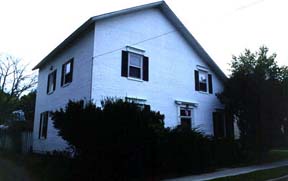

The Crooker House
 60 North Prospect Street
60 North Prospect Street
By Katharine K. Burns
Among the six houses along the corridor of Prospect Street highlighted in this study, the inclusion of this structure is probably the most contentious. The Historic Sites and Structures Survey (hereafter HSS) states that the "unusual old house probably dates from the 1920's or the 1930's," although Burlington historian David Blow disagrees, dating the house in the 1840s (1). Unfortunately, the National Register does not recognize the building, and thus cannot be called on to settle the argument. While the data is inconclusive, the Ammi B. Young map shows a footprint on this site, and it is probable that the Crooker house was part of the pre-1830 fabric of Burlington (2).
Mason William Eustis Crooker is the first known resident of the
house, which appears on the 1857 Wallings map and the 1869 Beers
atlas under his name (3).
Given Crooker's profession, Blow argues that he built the house
shortly after purchasing the property from Colonel Archibald Hyde
in 1841 (4). (The HSS
also postulates Crooker as the builder, yet provides no rationale
for dating the structure nearly twenty years before Crooker bought
the property.) In addition to his masonry work, Crooker also co-owned
a brickyard with his brothers. Married to Cordelia Crooker, the
couple had two daughters, Florence Nightingale and Arabella. The
Crooker family tenancy lasted for nearly a century. Florence,
who was born in the house in 1856, spent her entire life in the
residence. A 1877 graduate of the University of Vermont, she held
occasional jobs, but mainly "passed most of her life in her
residence on Prospect Street as housekeeper for her parents and
sister" (5). W. E.
Crooker died at the age of 82 in 1893, leaving the three women
alone in the house. The following decade brought the death of
older sister Arabella on 3 October 1901 as well as that of Cordelia
on 3 February 1903 (6).
According to the Burlington city directory, Florence remained
alone in the house until 1920, when she married Vermont-born retiree
Louis Shaw. Shaw, a UVM engineering graduate, held the residence
in his name. Florence was Louis' second wife, but the marriage
lasted only briefly, as she died on 7 June 1924. Shaw lived the
remainder of his life in the residence. On 12 December 1997, the
Crooker family's time at 60 North Prospect Street ended with his
death. According to Blow, Shaw bequeathed the house to the Mary
Fletcher Hospital (7),
which in turn sold the property to Leo and Rose Schildhaus.
The residence was listed as "vacant" in the city directory
until 1940, presumably the time in which the Schildhaus' converted
the house into apartments. The first apartment occupants were
UVM history assistant Arthur P. Silvester and the manager of the
Holland Furnace Company, Thomas O'Keefe. Silvester was the first
of many one-year UVM-affiliated personages to dwell in this house,
and O'Keefe only remained for three years. In 1941, however, Frank
and Marguerite McClure moved in, and the longevity of their residency
rivaled that of the Crooker's. Frank died in 1951, the same year
that Margaret and Hannah Hinman moved into the adjacent apartment.
This arrangement lasted for a decade, until Marguerite apparently
passed away, with her son and daughter-in-law remaining. Five
years later, the Hinmans were also gone. McClure was listed in
the directory as the sole occupant until 1982, when students moved
into the two other apartments.
In many ways, the history of the Crooker house shatters many notions
relating to the historical value of older structures. Its historicism
is virtually ignored both because its lays outside the typical
domain of "historic Burlington" with its campus buildings
and wealthy society members. In this respect, the vernacular expression
of Federalism combined with Greek Revival is under appreciated.
As the HSS states, the house "represents the earliest
style house found in this area" and "is first in a broad
spectrum of styles to be found on the street." Secondly,
despite the fact that the house has been modernized on both the
south and east facades (not shown in the photo), the residence
is remarkable for having maintained a strong sense of familiar
dwelling even after its conversion into apartments. Since Blow
stops his history after the conversion occurred, this encourages
the notion that a buildings history ends when a nuclear family
exits. As the McClures and Hinmans demonstrate, this is clearly
not the case at 60 North Prospect Street.
Sources |
| (1) Ammi B. Young, Plan of Burlington Village, 1830. Special Collections, University of Vermont. Burlington, Vermont. |
| (2) Wallings Map, Chittenden County, 1857; Beers Atlas, Chittenden County, 1869. |
| (3) David Blow, Historic Guide to Burlington Neighborhoods. Vol. 2. Lilian Baker Carlisle, ed. (Burlington, Vermont: Chittenden County Historical Society, 1991); Vermont Historic Sites and Structures Survey (Burlington, Vermont: Vermont Division for Historic Preservation, 1990). |
| (4) Blow, 109. |
| (5) Ibid. |
| (6) Burlington City Directory. The following information was obtained through a yearly scan of the directory, 1900-1980. |
| (7) Blow, 109. |
To STORRS HOUSE, 415 Pearl Street
Introduction | 1830 Young map | 1830-1988 overlay maps | Street index | Surviving 1830 buildings | UVM Historic Preservation Program